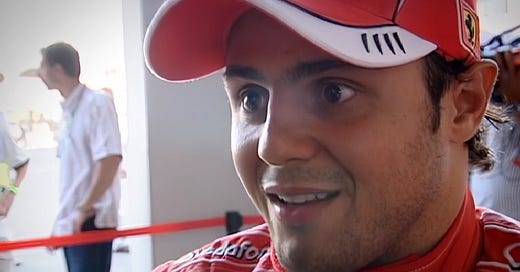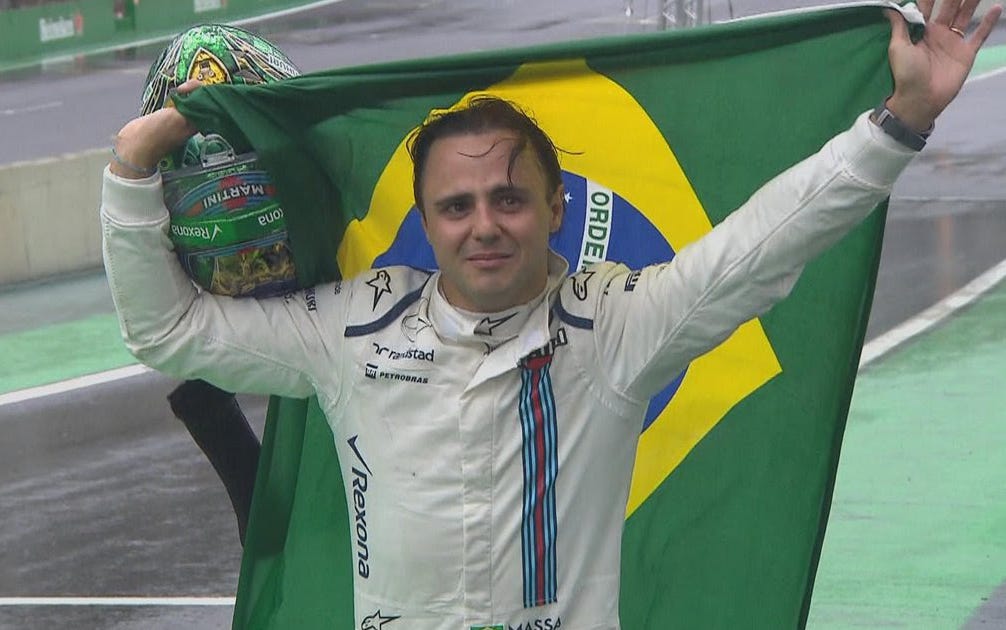The Benchmark: Felipe Massa
How the Brazilian fared, over a single lap, against some of the biggest names in the sport?
Felipe Massa retired over seven years ago, and these days he primarily makes headlines due to his legal battle concerning the 2008 championship, however, in this post, I want to focus on the times when he was fighting on the track, rather than in court.
The Brazilian has multiple pole positions and race wins on his resume, and he partnered with some remarkable names throughout his career. The purpose of this post is to illustrate how he fared against the likes of Schumacher, Raikkonen, Alonso, and others on Saturdays.
The Method
What I’m going to present here is the median qualifying gap between Massa and five of his teammates, expressed in symmetrical percentages. Pretty standard stuff.
In my view, representative gap between two given drivers means when they both performed their best. That’s why I chose to consider only the best laps set by teammates in the parts of qualifying sessions in which they participated. For instance, in Valencia 2010, both Alonso and Massa made it to Q3; however, the Brazilian clocked his best lap in Q2, so this one was used.
There are a few more examples like that. However, generally speaking, from 2010 onward, in the majority of instances, Massa and his teammates set their best times in the final segment of qualifying in which they participated.
My method also kind of bypasses one other problem. When the current qualifying format was introduced in 2006, we still had refueling in Formula 1. Additionally, teams were required by the regulations to run their cars in Q3 fueled for the first stint of the race. As a result, the lap times from years 2006-2009 were heavily influenced by the chosen strategies. Focusing on the best laps allows to select times usually set in Q1 or Q2 “on fumes.”
Although my approach, in principle “discriminates” against Q3 data from the aforementioned four years of refueling, it is ironic that on a couple of occasions, both Massa and Schumacher in 2006 set their best times in the final segment of qualifying.
Furthermore, for this analysis, wet sessions—defined as those in which drivers used intermediate or full wet tires—are excluded. Also not eligible is a rare instance of an unusual difference (approximately 4 seconds) in lap times at Sochi in 2014. In that session, Massa did not advance out of Q1 due to a fuel flow issue.

Michael Schumacher
Our hero joined Ferrari in 2006 and he kind of entered a lion’s den: the team ruled by Todt-Brawn-Schumacher triumvirate. Rob Smedley remembered in an interview on Beyond the Grid, Massa being a bit overwhelmed at the beginning of his journey in Maranello.
Fortunately for the Brazilian, had three years of experience with Bridgestone tires while racing for Sauber and testing for Ferrari. However, a year prior, Sauber had switched to Michelin. (2006 was the last year of two tire manufacturers in Formula 1.) The extent to which this fact, along with the psychological impact mentioned in the previous paragraph, influenced Massa’s performance is difficult to quantify. Nevertheless, I believe it is important to highlight.
Another important point to highlight is the situation regarding the Hungarian Grand Prix. The stewards issued a penalty to Schumacher for overtaking under a red flag during the final practice session. The penalty consisted of an additional 2 seconds added to the German driver's lap times in qualifying.
Schumacher’s official lap time in Q2 was 1:20.875, but the actual time was, of course, 1:18.875. I chose to use the latter. For the record, using the official time alters the median to 0.499%, while excluding the qualifying session from the data results in a median of 0.530%.
Kimi Raikkonen
After playing a supporting role for Schumacher during the German's final season at Ferrari, Massa competed with his new teammate on a more equal footing. In principle, this wasn't true because he had two additional years of experience at Maranello as a tester (2003) and as a full-time driver compared to Raikkonen.
Another advantage the Brazilian undoubtedly had, were 4 seasons of experience using Bridgestone tires. His teammate had only one from his rookie year at Sauber in 2001. He had to adapt, and he certainly did; during his championship-winning season and first year at Ferrari, Raikkonen was marginally faster than Massa by 0.035%.
It was only the following year that his form dwindled. In 2008, the Brazilian had the upper hand by 0.170%. However, Raikkonen adapted more effectively to the new regulations, and by 2009, the tables turned. The Finn was faster by 0.185% until that fateful Saturday in Hungary, when Massa suffered a season-ending injury. Had that incident not occurred and both teammates completed the year, the Finn would likely have ended up on the left side of the graph. However, that is merely my speculation.
Fernando Alonso
The Spaniard quickly established himself as the number one driver at Ferrari after joining the Maranello-based team. The data supports this assertion.
Although races, rather than qualifying, have been Alonso's forte, he also had an impressive margin over Massa on Saturdays during their first two years as teammates: 0.415% in 2010 and 0.443% in 2011.
The gap decreased to 0.321% in 2012 and, a year later, reached its lowest value of 0.153%. The latter is rather puzzling. It appears that Alonso had a so-so year in qualifying, because in races, he outperformed Massa in a manner similar to the previous three seasons.
I believe this notion is supported by how he outperformed Raikkonen in 2014. I mention this for a reason. Considering the performance medians of Massa-Alonso and Massa-Raikkonen, the Spaniard should have been faster than the Finn by 0.439%. However, he was not. His margin over Raikkonen in 2014 was only 0.385%. which is a difference of 0.054%.
So, at least in this instance, my approach serves as a reasonable predictor. However, this is not always true, as you will discover in the latter part of the post.
Valtteri Bottas
After eight years, Massa left Ferrari to join Williams, where he finished his career. Although he couldn't match the speed of his new teammate, Bottas, he was not far behind the Finn.
The Brazilian’s first season was his weakest compared to his teammate, being 0.198% slower. Massa narrowed the gap the following year to 0.136%. In 2016, the difference increased slightly to 0.149%, which is nearly the median of the three years they were teammates at Williams.
Lance Stroll
Massa first retired in 2016, which led to some memorable tears at Interlagos when the hometown hero bid farewell to Brazilian fans.
However, a certain turn of events un-retired Massa, more precisely: the retirement of fellow F1 driver and 2016 world champion Nico Rosberg. Mercedes Team Principal Toto Wolff, who was also Bottas' manager, secured his client a seat in a Silver Arrow.
That left Williams without a driver, so they called Massa and he took the offer. He raced for one additional season in 2017 and he practically demolished rookie Lance Stroll. A gap of 0.958% is reminiscent of the 1990s. It looks really bad.
However, Stroll has experienced a sort of redemption arc. Referring back to the Massa-Alonso median, the Spaniard should be significantly faster than his teammate at Aston Martin by whopping 1.316%. He is far from that.
At the time I am writing this post, before the USA Grand Prix at COTA, the gap between the two drivers is 0.333% in favor of Alonso. Why?
First of all, Stroll has improved and is not as bad as he was during his rookie season. On the other hand, Alonso is not performing at the same level he did in the early 2010s. Obviously he’s still great given he’s 43. However impressive his longevity is, still mammals inevitably decline with age. That’s a straightforward biological fact.
Limitations
The example above serves as a nice transition to the limitations of this type of analysis. Clearly, drivers' performance isn’t a flat line. It varies, fluctuates, and changes over time, as I hope this post illustrates. It is crucial to keep this in mind, especially since this analysis covers 12 seasons of Massa's career.
The question of whether Massa's accident at Hungaroring in 2009 negatively affected his performance is a topic of much debate. I’m among those who answer this question with “yes.” Therefore in my view, Raikkonen faced the best version of Massa, while all subsequent teammates competed against a diminished version of the Brazilian.
Although I cannot quantify the extent of the crash's influence, it is evident that various factors affected not only Massa but also his teammates.





